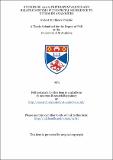Studies of 1, 6, 6a-trithiapentalenes and related systems, with special reference to nitrogen analogues
Abstract
An attempted synthesis of 1,6-dimethyl-6a-thia-1,6-diaza-pentalene from 2,5-dimethylisothiazolium perchlorate was unsuccessful. In the course of the work it was found that 2,5-dimethylisothiazolium perchlorate reacts with methylamine to give a thiophen derivative, the structure of which was proved by synthesis. The mechanism of the rearrangement is discussed. The reactions of 1,6, Ga-trithiapentalenes, 1-oxa-6,6a-dithia-pentalenes and 1,6a-dithia-6-azapentalenes with arenediazonium fluoroborates were studied, as part of a detailed investigation of the electrophilic substitution of 1,6,6a-trithiapentalenes and related systems. These reactions proceed by way of electrophilic attack at the 3(4)-position and rearrangement into derivatives of the 1,6a-dithia-5,6-diazapentalene system. When the substrate contains alkyl substituents at the 3- and 4-positions, formation of the 1,6a-dithia-5,6-diazapentalene involves displacement of a CHS, CHO or CHNMe group by the diazonium group. A mechanism accounting for the various features of the electrophilic substitution of 1,6 6a-trithiapentalenes and related systems is proposed. It is suggested that attack by an electrophile at the 3(4)-position of the 10pi bicyclic substrate generates a 6pi monocyclic intermediate. A general synthesis of 1-Ga-dithia-S,6-diazapentalenes and 1,6a-diselena-5,6-diazapentalenes has been developed, involving the reaction of 3-methyl(ene)-l, 2-dithiolium or 3-methyl(ene)-1,2-diselenolium salts with arenediazonium fluoroborates. The structure of 1,6a-dithia-5,6-diazapentalenes is discussed in the light of 1H nmr, electronic and mass spectral data and X-ray crystal structure data, and is compared with the structures of 1,6,6a~trithiapentalenes and 1,6a-dithia-6-azapentalenes. 1,6a-Dithia-5,6-diazapentalenes undergo electrophilic substitution at the 4-position. Bromination, formylation and nitration give the 4-substituted l, 6a-dithla-5,6-diazapentalenes, whereas nitrosation is accompanied by rearrangement into derivatives of the l-oxa-6, 6a-dithia-2-azapentalene system. Methylation of 1,6a-dithia-5,6-diazapentalenes with methyl fluoro- sulphonate affords 5-(2-methylthiovinyl)-1,2,3-thiadiazolium fluorosulphonates, which react with methylamine to give 6a-thia-1,2,6-triasapentalenes. 6a-Thia-l, 2,6-triazapentalenes are also obtained by the reaction of 1,6a-dithia-5,6~diazapentalenes with methylamine. Protonation of 1,6a-dithia-5,6-diazapentalenes in trifluoroacetic acid was studied by 1H nmr spectroscopy. The structures of the protonated species are discussed. 1,6a-Dlthia-5,6-diazapentalenes containing alkyl groups in the 3- and 4-positions are partially desulphurised by mercury (II) acetate to give l-Oxa-6a-thia-5,6-diazapentalenes. L-Oxa-6a-thla-5,6-diazapentalenes couple with arenediazonium fluoroborates to give 6a-thia-1,2,5,6-tetraazapentalenes. Symmetrically substituted 6a-thia-1,2,5,6-tetraazapentalenes show real or time-averaged symmetry in solution and are formulated as bicyclic structures of the 1,6,6a-trithiapentalene type.<p>
This thesis is divided into three sections, Parts 1, 2 and 3. Each part is divided into a number of principal sections, each prefixed by a capital letter. Part 1 consists of a review of the background literature relevant to the work embodied in this thesis.
Part 2 is a discussion of the results achieved in the course of the investigation.
Part 3 is devoted to a description of the experimental details and is complementary to Part 2.
Tables of nmr, ultraviolet and visible and mass spectral data are contained in Appendices A, B and C respectively.
Where reference is made to the chemical literature, this is indicated by a nu,ber in superscript, a key to which can be found at the end of the thesis. The structural formulae which have been reproduced for illustrative purposes have been assigned Arabic numerals, which correspond to the numbers which have been assigned to the relevant compounds in the text. The structure keys to parts 1 and 2 are distinct. The structure key to part 3 is the same as that for part 2.
Type
Thesis, PhD Doctor of Philosophy
Collections
Items in the St Andrews Research Repository are protected by copyright, with all rights reserved, unless otherwise indicated.

